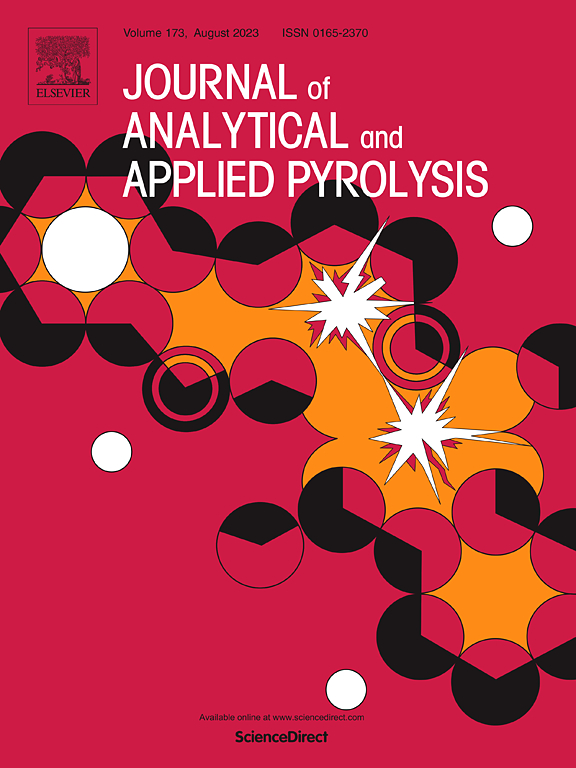Influence of volatiles-char interaction during torrefied biomass and coal co-pyrolysis on char structure: Comparison of different decoupling studies
IF 5.8
2区 化学
Q1 CHEMISTRY, ANALYTICAL
引用次数: 0
Abstract
Co-pyrolysis of torrefied biomass and coal was a potential path to achieve the high-efficiency and large-scale co-utilization of these two carbonaceous feedstocks. Interaction between volatiles and char was an inevitable reaction during co-pyrolysis, and thus impacts the char structure. This work was aimed to conducting a comparison of different decoupling studies to make a clearer understanding of this interaction. Torrefied biomass is prepared at 200, 250, and 300 °C (RST200–300) in a fixed bed reactor, followed by co-pyrolysis with coal (BC) and coal char (BCC) at various ratios. RST-BC co-pyrolysis reduces oxygen-containing functional groups on the BCC surface, with the total amount decreasing from 33.1 % to 30.0 %, and decreases the C-O-C peak intensity of decoupled BCC. Compared with single BCC, co-pyrolysis of RST200/250-BC at 3:1 ratio increases C-O content by 3.5 % and 3.1 %, respectively. RST200-BC co-pyrolysis enhances the order degree of BCC, while RST250/300-BC co-pyrolysis reduce it. RST-BCC co-pyrolysis increases the C-O-C peak intensity on the BCC surface, but this effect is diminished for RST prepared at higher temperatures. During RST200/250-BCC co-pyrolysis, the order degree of decoupled BCC decreases, but RST300-BCC co-pyrolysis shows a converse effect. The impact of volatiles on the carbon structure evolution of coal char enhances with increasing RST ratios. For RST-BC/BCC co-pyrolysis, the C-C content on BCC surface increased, particularly for RST200 at a 3:1 ratio, with C-C content increased by 3.5 % and 3.4 %. These findings suggest that volatiles interactions during co-pyrolysis reduce oxygen-containing groups on the BCC surface and alter its ordered structure.
碳化生物质和煤共热解过程中挥发物-炭相互作用对炭结构的影响:不同解耦研究的比较
碳化生物质与煤共热解是实现这两种碳质原料高效大规模共热解的潜在途径。挥发分与炭的相互作用是共热解过程中不可避免的反应,从而影响了炭的结构。这项工作旨在对不同的解耦研究进行比较,以更清楚地了解这种相互作用。在固定床反应器中,分别在200、250和300℃(RST200-300)条件下制备碳化生物质,然后与煤(BC)和煤焦(BCC)按不同比例共热解。RST-BC共热解减少了BCC表面的含氧官能团,总量从33.1% %下降到30.0 %,降低了解偶BCC的C-O-C峰强度。与单一BCC相比,RST200/250-BC以3:1的比例共热解,C-O含量分别提高了3.5 %和3.1 %。RST200-BC共热解提高了BCC的有序度,而RST250/300-BC共热解降低了BCC的有序度。RST-BCC共热解增加了BCC表面的C-O-C峰强度,但在较高温度下制备的RST这种效应减弱。在RST200/250-BCC共热解过程中,解耦BCC的有序度降低,而RST300-BCC共热解则呈现相反的效果。挥发分对煤焦碳结构演化的影响随RST比的增加而增强。对于RST-BC/BCC共热解,BCC表面的C-C含量增加,特别是RST200以3:1的比例增加,C-C含量分别增加3.5 %和3.4 %。这些发现表明,共热解过程中挥发物的相互作用减少了BCC表面的含氧基团并改变了其有序结构。
本文章由计算机程序翻译,如有差异,请以英文原文为准。
求助全文
约1分钟内获得全文
求助全文
来源期刊
CiteScore
9.10
自引率
11.70%
发文量
340
审稿时长
44 days
期刊介绍:
The Journal of Analytical and Applied Pyrolysis (JAAP) is devoted to the publication of papers dealing with innovative applications of pyrolysis processes, the characterization of products related to pyrolysis reactions, and investigations of reaction mechanism. To be considered by JAAP, a manuscript should present significant progress in these topics. The novelty must be satisfactorily argued in the cover letter. A manuscript with a cover letter to the editor not addressing the novelty is likely to be rejected without review.

 求助内容:
求助内容: 应助结果提醒方式:
应助结果提醒方式:


